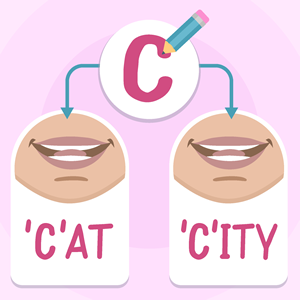Phonics Phase 5: Further Development

Phonics Phase 5: Further Development
In Phase Five, children continue to build on the phonics skills that they learned in Phases One to Four. They add an additional 19 graphemes to their repertoire, learn more spelling rules and patterns, and gradually improve their reading speed and accuracy.
Many of the new graphemes in this phase introduce different ways to write the same sound, and different ways to sound out the same grapheme. The 's' sound, for example, can be written as either s, as in serial, or c, as in cereal. The two new consonant digraphs pupils learn are also examples of alternate ways to write sounds. The ph digraph used in words like telephone is a new way of writing the 'f' sound. The wh digraph is read as 'w' or 'wh' (depending on your pronunciation) in where, it can also be read as 'h' in the word who.
New vowel combinations give children more new ways to write sounds. In Phase Three they met the 'ur' sound found in the word curl. Now they learn that this sound can be written 'ir' as in girl. They also learn that:
- The 'ow' sound in snow can also be written oe as in toe
- The 'ee' sound in see can also be written ea as in sea
- The ea grapheme can be pronounced in different ways, not only as the 'ee' in sea, but as 'e' as in head, and 'ay' as in break.
- The 'aw' sound can be written both as aw in saw and au as in dinosaur
- The 'ou' sound can be written as ou in out, and also as ow in now
- The 'dge' sound is written as g in giraffe, ge in huge and dge in judge
- The grapheme ie can be read 'eye' as in pie as well as 'ee' as in field
- The grapheme ue can be read as 'oo' (blue) as well as 'yoo' (dew)
- The same applies to ew, which can be read as 'oo' (grew) or as 'yoo' (new)
- The letter y can be both a consonant and a vowel. It is read as a consonant at the beginning of words like yellow. However, it is read like the vowel i at the end of words like happy, day and boy
Children learn even more ways to write sounds, when they learn the vowel plus consonant plus e pattern. This is where adding an e to the end of a word changes the sound of that word by altering the sound of the first vowel, as in the following examples:
- mad + e = made
- pet + e = Pete
- rid + e = ride
- rod + e = rode
- cub + e = cube
As they learn alternative spellings, pupils are also introduced to homophones and homographs. Homophones are words like pale and pail that sound the same but which are spelled differently.
Homographs are words that are spelt the same but pronounced differently, such as bow meaning to bend at the waist and bow meaning a way to tie a ribbon. They also learn more contractions such as can't, didn't, and couldn't, and the difference between it's as an abbreviation for 'it is' or 'it has' and the possessive its (e.g. 'The dog ate its dinner').
Exception or sight words introduced in this phase include Mr. and Mrs., their, people and could. Looked, called and asked are also part of this group because pupils do not yet know the rules for adding -ed to verbs. They will learn these in Phase Six.
Parents and teachers also need to be aware that there are some words that may be exception words in some accents, but not in others. For example, the word bath is pronounced irregularly as 'barth' or 'baath' in some accents but quite regularly, rhyming with 'maths', in others.
Pupils also work on punctuation and spelling, which becomes much more challenging now that they have to think about homophones and homographs. They learn different spellings for the same sound, and are introduced to silent letters, such as the k in knew, and the g in gnat, along with other irregular ways of reading words.
Now is a good time for your child to join the library. Encouraging children to pick out and read their own library books helps them to become independent readers. Also, by allowing them to read a variety of books, including both fiction and nonfiction, you will encourage them to practise their phonics skills, improve their reading fluency, and become confident readers.
Continue reading: Phonics Phase 6: Achieving Fluency

